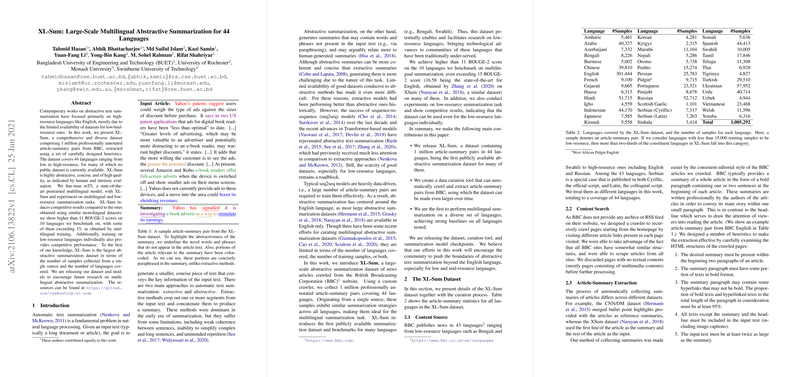Overview of XL-Sum: A Comprehensive Multilingual Abstractive Summarization Dataset
The research paper introduces XL-Sum, an extensive dataset designed for multilingual abstractive summarization, covering 44 languages. This dataset addresses a significant gap in existing resources, as most previous efforts have concentrated on high-resource languages, leaving many low and mid-resource languages without adequate data for model training and evaluation. The dataset consists of 1 million professionally annotated article-summary pairs extracted from BBC articles, employing heuristics to ensure high quality and abstraction in the summaries. This paper's primary contribution is not only the creation of XL-Sum but also the provision of a standard resource for researchers focusing on low-resource languages.
Dataset Characteristics and Contributions
XL-Sum is distinguished by its scale and scope, as it is the largest known abstractive summarization dataset in the number of languages covered and the volume of data from a single source. The dataset's languages range from widely spoken ones such as English, Hindi, and Chinese to lesser-resourced languages like Azerbaijani and Amharic. Notably, for many constituent languages, XL-Sum provides the first publicly available summarization dataset, marking a crucial step towards enabling research and development for these linguistic communities.
The dataset's summaries are highly abstractive. They are generated through a structured methodology, utilizing BBC's consistent editorial styling where summaries are given upfront in bold text. This approach enables the authors to collect summaries that effectively distill articles' main points without directly lifting text, encouraging quality that is both concise and coherent. The dataset is notably extensible, allowing for growth as more data becomes available.
Empirical Evaluation and Baselines
The paper presents comprehensive empirical evaluations using the mT5 model, a state-of-the-art multilingual sequence-to-sequence model. The authors perform experiments on multilingual and low-resource scenarios, establishing several benchmarks. In multilingual settings, where a single model handles all 44 languages, the model achieves ROUGE-2 scores exceeding 11 across all evaluated languages, which is competitive considering the diverse linguistic dataset. For instance, in English, comparable performance is observed with existing benchmarks derived from XSum, a dataset with similar characteristics but limited to English.
The experiments also extend to low-resource settings, demonstrating that fine-tuning models on individual languages—even those with fewer data samples—produces results closely aligned with multilingual models. This finding highlights XL-Sum's utility even in constrained computational environments and reaffirms its potential to foster advancements in under-researched languages.
Implications and Future Directions
The implications of XL-Sum are twofold: practical and theoretical. Practically, the dataset enables the development of robust multilingual summarization models, fostering technological inclusivity for languages previously considered under-resourced. Theoretically, it provides a fertile ground for research into multilingual and cross-lingual NLP models, enabling studies of positive transfer among linguistically similar languages.
Looking forward, this dataset could inspire studies in cross-lingual summarization, where models are trained on one language and evaluated on another, extending the reach of summarization capabilities to more global contexts. Additionally, the approach of utilizing consistent data sources for cross-linguistic dataset creation may serve as a model for future dataset compilation efforts in NLP.
In conclusion, XL-Sum represents a significant advancement in multilingual abstractive summarization datasets. Its comprehensive nature not only fills a critical gap for resource-constrained languages but also paves the way for inclusive and wide-reaching NLP research. The release of this dataset is likely to catalyze further studies and applications for languages that have historically been underrepresented in computational linguistics.
